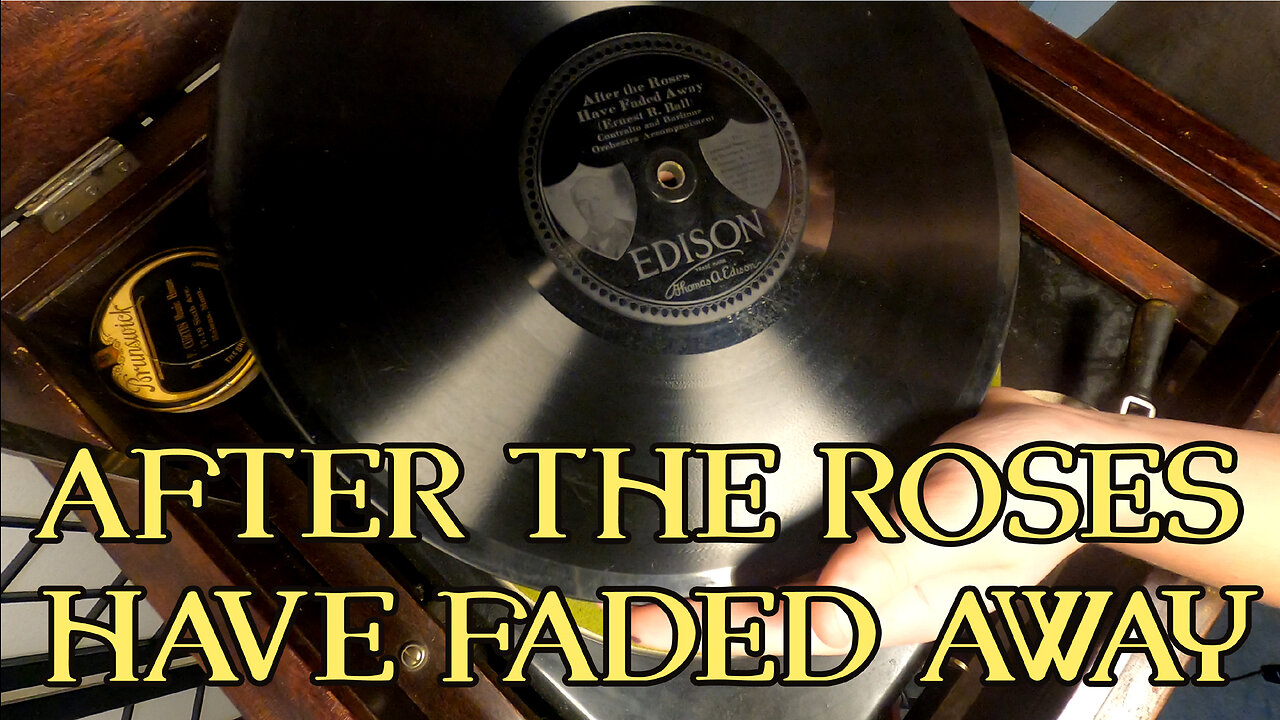Premium Only Content

1918 Edison Phonograph - After the Roses Have Faded Away
The melody for this song was written by Ernest R. Ball, 1878-1927.
Few music publishers ever got a better deal than Witmark did when he recruited Ernest Ball as a staff pianist at $20 a week. Even the members of the firm did not realize what a bargain they were getting when they first interviewed this unassuming young laid back guy.
Ball taught piano at the age of thirteen to earn money to complete his musical education. He graduated from the Cleveland Conservatory of Music. With little Professional experience Ball got on at Witmark's Music Publishing House.
Three years later Ball had his first big hit, Will You Love Me In December As You Do In May?
The Witmarks had a potential genius in their demonstrating rooms who could write better songs than just about any other staff member. Ball was promoted to staff composer, signed up to a 20-year contract, and cranked out an unprecedented number of hits, some very big ones.
The composer was a sentimentalist who aimed his songs at the most vulnerable of targets-the hearts of his customers. He discovered a success formula early in his career and stuck to it religiously, specializing only in ballads.
Ernest Ball was also able to work with good lyricists. These included Dave Reed, Jr., Arthur Lamb, Rita Johnson Young, Paul Laurence Dunbar, the eminent poet, and Caro Roma, the composer of Can’t You Hear Me Callin’ Caroline? His greatest hits, however, were written in collaboration with George Graff and J. Kiern Brennan.
Title: After the roses have faded away
Names:
Ball, Ernest R. (composer)
Buchanan, Bessie (lyricist)
Created / Published:
M. Witmark & Sons, New York, 1914.
****************************
*****************
The 1918 Edison Model C150 is an 80 RPM Phonograph that sold for $175 in 1918. That is today's equivalent of approximately $4000. 18,000 of these phonographs were manufactured.
*****************
In the early 20th century, Edison phonographs were well-established as one of the leading brands in the industry. They were known for their high-quality sound reproduction and durability. By 1918, many Edison phonographs were equipped with electric motors, which improved their reliability and made them more convenient to use compared to earlier spring-wound models.
Edison phonographs typically played cylindrical records, which were different from the flat, disc-shaped records used by competitors like the Victor Talking Machine Company (which later became RCA Victor). Edison's cylinder records were known for their fidelity, and the company had a vast catalog of music and spoken word recordings.
However, by the late 1910s, the popularity of flat disc records was on the rise, and Edison faced increasing competition from companies like Victor. This led to a decline in the market share of Edison phonographs.
In summary, the Edison Phonograph Company in 1918 was producing high-quality phonographs known for their durability and sound quality, but they were facing stiff competition from companies using flat disc records, which eventually led to a decline in their market presence.
Contact AOWS at: anythingoutdoorswithsteve@gmail.com
#Edison #roses #oldmusic
-
 6:35
6:35
Quest for Happiness
10 months agoA Great Adventure: Journey Across Wondrous Lands - On The March 🐜 🐜 🐜 🐜
329 -
 25:41
25:41
SB Mowing
18 hours agoPICTURE living next to THIS and not knowing what to do…
124K54 -
 2:16:01
2:16:01
George Galloway
1 day agoNEW YEAR COUNTDOWN - MOATS with George Galloway - EP 408
128K237 -
 18:39
18:39
Stephen Gardner
14 hours ago🔥BREAKING! Trump's SHOCKING New Demand | Biden admits DOJ TARGETED Trump Illegally!
99.6K397 -
 1:20:23
1:20:23
Josh Pate's College Football Show
20 hours ago $15.35 earnedCFP Prediction Special: OhioSt vs Oregon | UGA vs Notre Dame | Texas vs ASU | Boise vs PennSt
124K6 -
 7:50:03
7:50:03
Scottish Viking Gaming
18 hours ago💚Rumble :|: SUNDAY FUNDAY :|: Virginia has two Verginers, Change my Mind!
129K18 -
 1:49:50
1:49:50
Winston Marshall
2 days agoThe DARK Reality of Socialism - Historian Giles Udy
101K128 -
 1:09:28
1:09:28
Sports Wars
16 hours agoBengals STAY ALIVE In OT Thriller, ESPN's Ryan Clark SLAMMED, NFL DESTROYS NBA On Christmas
83.7K18 -
 9:37
9:37
EvenOut
1 day ago $5.62 earnedThe Non-Reflecting Mirror Scare Twin Prank!
71.4K5 -
 11:19
11:19
Tundra Tactical
1 day ago $7.18 earnedI Saw How CMMG Makes Guns.
76.9K8